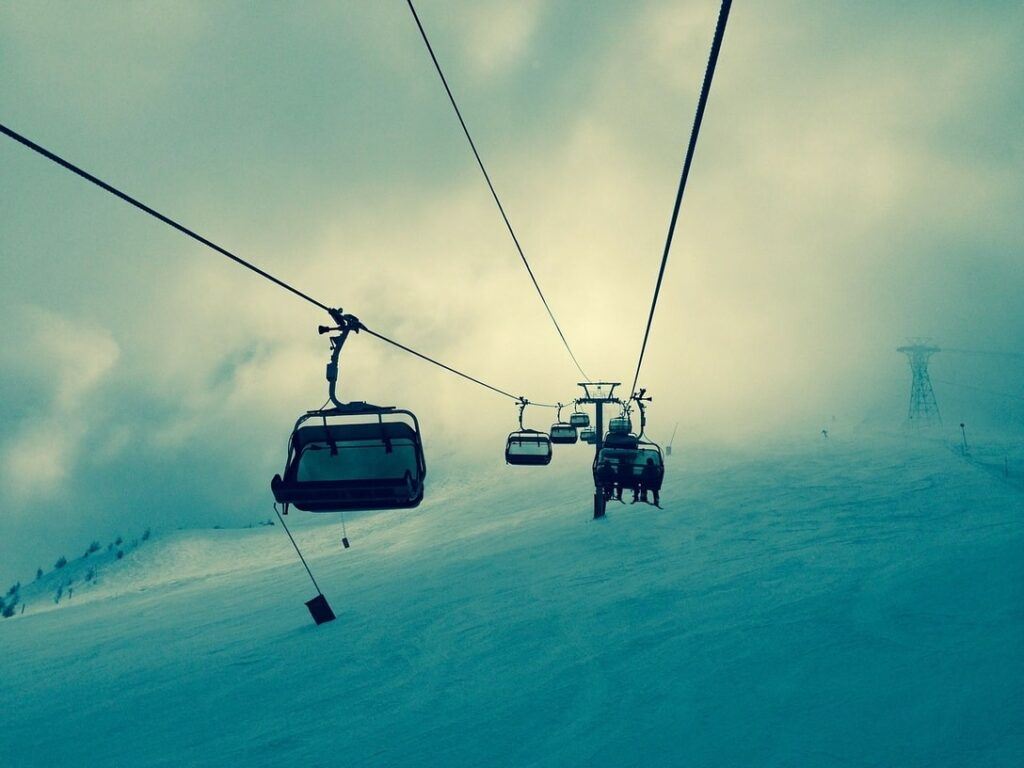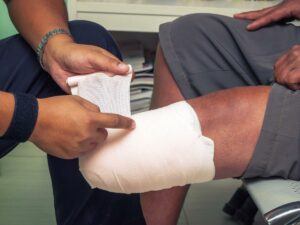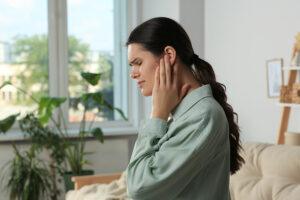Winter presents fresh challenges for the first-aider.
There are many great outdoor activities to enjoy this season, but it’s also important to be aware and cautious of the potential dangers.
Prepare yourself for dealing with cold-weather injuries by brushing up on your first-aid skills.
The 8 Key Challenges For First-Aiders In The Winter Months
1. Hypothermia
Hypothermia sets in when your body temperature drops below 35°C.
This usually happens with prolonged exposure to temperatures below 10°C, or after being in water with a temperature of less than 20°C for a length of time.
A person with hypothermia may not be aware of their need for medical attention. And a body temperature below 32°C is often life threatening.
Children, the elderly, and people with low body fat percentages are at particular risk of hypothermia.
Symptoms of hypothermia include shivering, mental confusion, lack of coordination, or fluctuating heartbeats.
Excessively pale, blue, or swollen skin may occur in extreme cases.
Call an ambulance if you suspect someone near you has hypothermia.
Try to move the person away from the cold if possible, either inside, or by covering them up. If their clothes are wet, remove them and replace them with dry clothing or wrap them in a warm blanket.
Applying direct heat to the cold parts of the body at this time can do more harm than good, so instead try using a warm (not hot) compress to central areas of the body including the chest, neck, and head before attempting to warm up the extremities.
CPR should be initiated if a person’s breathing stops, appears shallow, or is extremely slow.
2. Sprains, Strains, And Broken Bones From Falls And Slips
Sprains and strains happen when joints, muscles, tendons, and ligaments are stretched to the point of injury.
In winter, this often occurs after a slip or a fall on icy surfaces, such as paths and driveways. Pedestrians are at much greater risk of falling in these conditions.
To treat a sprain or a strain, remember the acronym, “RICE”. It stands for Rest, Ice, Compression, and Elevation. For more serious injuries, see your doctor.
For broken bones, don’t move the injured person or try to straighten the injured area.
Instead, apply a splint (if you are trained), and treat the person for shock by keeping them warm and applying ice (not directly to skin) to reduce swelling until professional help arrives.
3. Burns
Winter is a time when we turn to our heaters and fireplaces for comfort.
This presents a risk of serious burns, plus there are the added dangers of faulty electric blankets and damaging hot liquids we prepare to keep ourselves warm.
Should burns occur, immediately hold the burned area under cool (not cold) running water for at least 20 minutes or apply a cool, wet compress until the pain eases.
Follow the DRSABCD process where applicable: Danger, Response, Send for help, Airway, Breathing, Cardiopulmonary resuscitation (CPR) and Defibrillation.
Cover the burn with a light, loose non-stick dressing.
If the burn is severe or if it involves the airway, call triple zero (000) for an ambulance.
Remove all clothing and jewellery from the burnt area, unless they are stuck to the burn.
Continue to check the patient for shock, and treat if necessary, then seek medical attention.
4. Frostbite
Cold weather affects the flow of blood and oxygen to body parts because blood vessels restrict and freeze body tissue. Frostbite happens when skin cells and the tissues beneath freeze up, causing cell damage.
Affected areas are often the extremities, as well as areas of exposed skin. A person’s fingers, cheeks, chin, ears, and nose are especially vulnerable.
Frostbite manifests itself as pale or red skin; hard or waxy skin; and numbness or prickling. Symptoms of very severe frostbite can include blisters and severe pain.
If possible, remove anyone who has frostbite from the cold. Frozen hands should be tucked into armpits if not covered. It is not advisable to rub or massage the skin, since this can lead to further injury. Wet clothing should be removed.
After you’ve reached a warm environment, soak the frostbitten area in warm water (not hot) for 15 to 30 minutes. Don’t use direct heat either, such as a heating pad or from a fireplace. Paracetamol, aspirin, or ibuprofen can ease the pain of rewarming. If feet or toes are frostbitten, avoid walking on them.
If the skin is frostbitten, it will turn red and become tingly or burn as it warms. Blisters or numbness are signs of severe frostbite that needs medical attention.
You can prevent frostbite in cold conditions by wearing layers. The first layer keeps you dry, the second acts as an insulator, while the third layer should be both wind and waterproof.
5. Sunburn
You can be just as at risk of sunburn in winter as in summer.
It’s especially true if you’re on snowy ground, which reflects over 75% of the sun’s most damaging rays. Colder weather tends to make us more complacent about sunburn.
Sunburn causes the skin to redden, and in extreme cases it can blister.
You can soothe sunburn with cold compresses or cool flowing water.
Remember to stay hydrated and stay out of direct sunlight as much as possible, and apply sunscreen often. It’s important to put sunscreen on all exposed skin before spending time outside.
6. Winter Sports Injuries
Sports injuries result in around 36,000 Australians aged 15 and over every year staying in hospital. And winter sports can be especially rough on the body.
This is because cold weather tends to decrease our muscles’ flexibility, which increases the risk of injury.
The best way to avoid injury is by preparing yourself better in winter: wear layers, make sure your equipment is in good order, wear well-fitted protective gear, and warm up for longer before any strenuous activity.
Some winter sports are more challenging than others. Make sure you take lessons from an expert and avoid taking risks. Wear bright colours and protect your eyes from any glare.
Be prepared for signs and instances of concussion, dislocated shoulders or other body parts, spinal injuries, knee injuries, ankle sprains and fractures.
7. Carbon Monoxide Poisoning
Known as “the silent killer”, carbon monoxide poisoning is a result of the emission of odourless, colourless carbon-containing gases from burning fuels (like wood, gas, coal).
There are more instances of it in winter because people tend to use their gas furnaces and heaters.
When the weather is cold, symptoms of carbon monoxide poisoning often resemble viral illnesses, such as colds and flu. Headaches, drowsiness, fatigue, irritability, confusion, and fatigue can all be caused by low-dose exposure.
Carbon monoxide poisoning is a medical emergency.
The NSW Poisons Information Centre recommends:
- Immediately get the person to fresh air, without placing yourself at risk
- Avoid breathing in the fumes
- If it is safe to do so, open doors and windows wide
- If the victim isn’t breathing, start resuscitation and call an ambulance on 000
- Call the Poisons Information Centre on 13 11 26
8. Driving And Motor Vehicle Collisions
The majority of us must continue working and carry on with our everyday lives despite winter weather conditions.
Winter driving can be dangerous if you aren’t prepared and don’t take the proper safety precautions.
Consider a vehicle first-aid kit as your first step to being prepared for accidents on the road.
In the winter, visibility is reduced by shorter, darker days, bad weather such as rain, hail, fog, or snow. Slush, ice, and high winds can make it difficult for vehicles to stay in control. Glare is a common problem during the winter season due to the low sun.
First-aiders at the scene of a road accident should alert oncoming traffic that there has been an accident.
As there may be spilled fuel or other fire hazards, turn off any vehicle ignitions if it is safe to do so. Then make sure all hazard lights are turned on.
Please contact Triple-0 or ask a bystander to do so.
If the victim is unconscious or is experiencing difficulty breathing, follow your training.
Make sure that the victim’s head, neck, and back are treated with great care.
Placing blocks at either end of the neck will ensure it stays in place. In the absence of this, make sure the victim is not moved by shaking them to stay awake.
It is not advisable to remove a victim’s helmet unless he or she is unconscious or barely breathing. Until an ambulance arrives, mouth-to-mouth resuscitation and CPR may be necessary.
Winter Injury Prevention Tips
- Warm-up a bit longer before exercise in the winter months
- Take regular breaks – don’t overdo it
- Keep hydrated – Reduced fluid intake during winter can cause your core temperature to drop. Keep hydrated by drinking plenty of fluids, but avoid caffeinated and alcoholic beverages as they could dehydrate you.
- Keep warm – wear extra layers. Go for a thick, wind-resistant coat or jacket. Protect your extremities with hats, scarves, gloves, and waterproof boots.
- Walk and drive extra carefully according to conditions – watch for ice on pathways and roads. Slow down in winter weather
- Have your car fully checked up before winter
- Wear shoes with solid grip and traction to avoid slips and falls
- Make sure all walkways are cleared of ice where possible
- Keep your distance from those who are sick with colds or the flu
Buy a first-aid kit and be prepared for any weather-related emergency.
With more than 20 years experience in the industry, Vital First Aid Training Services is the leader in First Aid and CPR training courses. Sign up for a course today.






